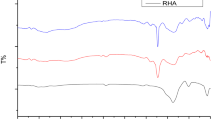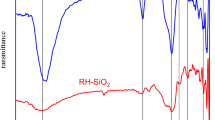Abstract
The world is moving toward using the best scientific methods to get rid of environmental pollution. Rice husks are one of the agricultural wastes produced daily in all parts of the world. Therefore, it was found in the previous literature to use this substance in producing valuable materials because of its high percentage of silica. Sodium silicate was prepared from rice husks, then reacted with 3-(aminopropyl)triethoxysilane to produce RH-SiO2PrNH2, and then reacted with 2-amino-3,5-dibromobenzaldehyde to produce RH-SiO2PrADB. CHN and FTIR techniques were relied upon to propose the synthesis of the prepared compound. X-ray procedure revealed the amorphous nature of the compound. N2 adsorption–desorption analysis showed a specific surface area of 0.789 m2 g−1 for RH-SiO2PrNH2 and 3.818 m2 g−1 for RH-SiO2PrADB. The modified organic–inorganic silica displayed a restricted 3–20-nm pore size distribution. The particles and pores of organic–inorganic hybrid modified silica were found to be randomly dispersed, with a tendency to be uniformly spherical particles, according to atomic force microscopy (AFM) analysis, field emission scanning electron microscopy (FESEM), and transmission electron microscopy (TEM). The uptake results showed that the maximum adsorption efficiency in acidic medium was up to 96%, 95.5%, and 95% for Co(II), Ni(II), and Cu(II), respectively. Under the impact of various circumstances, the produced RH-SiO2PrADB was employed to extract the metal ions Co(II), Ni(II), and Cu(II) from their aqueous solutions.



















Similar content being viewed by others
Data availability
The text contains the necessary information and materials.
References
Verma DK, Srivastav PP (2020) Bioactive compounds of rice (Oryza sativa L.): review on paradigm and its potential benefit in human health. Trends Food Sci Technol 97:355–365. https://doi.org/10.1016/J.TIFS.2020.01.007
Dai XJ, Yang YZ, Zhou L et al (2012) Analysis of indica- and japonica-specific markers of Oryza sativa and their applications. Plant Syst Evol 298:287–296. https://doi.org/10.1007/s00606-011-0543-y
Muthayya S, Sugimoto JD, Montgomery S, Maberly GF (2014) An overview of global rice production, supply, trade, and consumption. Ann N Y Acad Sci 1324:7–14. https://doi.org/10.1111/nyas.12540
Bailey TA, Zhou X, Chen J, Yang Y (2009) Role of ethylene, abscisic acid and MAP kinase pathways in rice blast resistance. Advances in genetics, genomics and control of rice blast disease. Springer, Netherlands, Dordrecht, pp 185–190
Zou Y, Yang T (2019) Rice husk, rice husk ash and their applications. Rice Bran Rice Bran Oil Chem Process Util 207–246. https://doi.org/10.1016/B978-0-12-812828-2.00009-3
Kim S, Dale BE (2004) Global potential bioethanol production from wasted crops and crop residues. Biomass Bioenerg 26:361–375. https://doi.org/10.1016/j.biombioe.2003.08.002
Amagliani L, O’Regan J, Kelly AL, O’Mahony JA (2017) Composition and protein profile analysis of rice protein ingredients. J Food Compos Anal 59:18–26. https://doi.org/10.1016/j.jfca.2016.12.026
Champagne ET (2004) Rice: chemistry and technology. (No. Ed. 3). American Association of Cereal Chemists. https://www.cabdirect.org/cabdirect/abstract/20053047364
Jiao G, Wei X, Shao G et al (2014) Impact of rice flour cold-water-soluble fraction removal on gelatinization and pasting properties. Cereal Chem 91:473–481. https://doi.org/10.1094/CCHEM-11-13-0227-R
Chandrasekhar S, Pramada PN, Majeed J (2006) Effect of calcination temperature and heating rate on the optical properties and reactivity of rice husk ash. J Mater Sci 41:7926–7933. https://doi.org/10.1007/s10853-006-0859-0
Della VP, Kühn I, Hotza D (2002) Rice husk ash as an alternate source for active silica production. Mater Lett 57:818–821. https://doi.org/10.1016/S0167-577X(02)00879-0
Ningthoujam R, Jangid P, Yadav VK et al (2023) Bioethanol production from alkali-pretreated rice straw: effects on fermentation yield, structural characterization, and ethanol analysis. Front Bioeng Biotechnol 11:1–9. https://doi.org/10.3389/fbioe.2023.1243856
Zareihassangheshlaghi A, Dizaji HB, Zeng T et al (2020) Behavior of metal impurities on surface and bulk of biogenic silica from rice husk combustion and the impact on ash-melting tendency. ACS Sustain Chem Eng 8:10369–10379. https://doi.org/10.1021/acssuschemeng.0c01484
Hassanien MM, Mortada WI, Kenawy IM (2015) Selective separation of palladium from synthetic highly active liquid waste by cloud point extraction using benzil mono-(2-pyridyl)hydrazone and Triton X-114. J Radioanal Nucl Chem 303:261–269. https://doi.org/10.1007/s10967-014-3430-5
Ding TP, Ma GR, Shui MX et al (2005) Silicon isotope study on rice plants from the Zhejiang province, China. Chem Geol 218:41–50. https://doi.org/10.1016/j.chemgeo.2005.01.018
Sun C, Chen T, Huang Q et al (2019) Enhanced adsorption for Pb(II) and Cd(II) of magnetic rice husk biochar by KMnO4 modification. Environ Sci Pollut Res 26:8902–8913. https://doi.org/10.1007/s11356-019-04321-z
El-Ashgar NM, El-Nahhal IM, Chehimi MM et al (2007) A new route synthesis of immobilized-polysiloxane iminodiacetic acid ligand system, its characterization and applications. Mater Lett 61:4553–4558. https://doi.org/10.1016/j.matlet.2007.02.050
El-Ashgar NM, El-Nahhal IM, Chehimi MM et al (2009) Preparation of ethylenediaminetriacetic acid silica-gel immobilised ligand system and its application for trace metal analysis in aqueous samples. Int J Environ Anal Chem 89:1057–1069. https://doi.org/10.1080/03067310902717278
Huang Z, Wu P, Gong B et al (2016) Efficient removal of Co2+ from aqueous solution by 3-aminopropyltriethoxysilane functionalized montmorillonite with enhanced adsorption capacity. PLoS ONE 11:1–18. https://doi.org/10.1371/journal.pone.0159802
Mohsin AD, Mihsen HH (2020) Uptake of metal ions (Co(II) and Ni(II)) by silica-salicylaldehyde derived from rice husks. J Inorg Organomet Polym Mater 30:2172–2181. https://doi.org/10.1007/s10904-019-01379-7
Abbas SH, Adam F, Muniandy L (2020) Green synthesis of MCM-41 from rice husk and its functionalization with nickel(II) salen complex for the rapid catalytic oxidation of benzyl alcohol. Microporous Mesoporous Mater 305:110192. https://doi.org/10.1016/j.micromeso.2020.110192
Ali HH, Hussein KA, Mihsen HH (2023) Antimicrobial applications of nanosilica derived from rice grain husks. SILICON. https://doi.org/10.1007/s12633-023-02467-7
Nguyen TT, Ma HT, Avti P et al (2019) Adsorptive removal of iron using SiO 2 nanoparticles extracted from rice husk ash. J Anal Methods Chem 2019:1–8. https://doi.org/10.1155/2019/6210240
Das T, Roy A, Uyama H et al (2017) 2-Hydroxy-naphthyl functionalized mesoporous silica for fluorescence sensing and removal of aluminum ions. Dalt Trans 46:7317–7326. https://doi.org/10.1039/c7dt00369b
Parambadath S, Mathew A, Barnabas MJ et al (2016) Concentration-dependant selective removal of Cr(III), Pb(II) and Zn(II) from aqueous mixtures using 5-methyl-2-thiophenecarboxaldehyde Schiff base-immobilised SBA-15. J Sol-Gel Sci Technol 79:426–439. https://doi.org/10.1007/s10971-015-3923-x
Sobh HS, Mihsen HH (2019) Synthesis of functionalized silica from rice husks containing C-I end group. Baghdad Sci J 16:0886. https://doi.org/10.21123/bsj.2019.16.4.0886
Mureseanu M, Reiss A, Stefanescu I et al (2008) Modified SBA-15 mesoporous silica for heavy metal ions remediation. Chemosphere 73:1499–1504. https://doi.org/10.1016/j.chemosphere.2008.07.039
Mihsen HH, Abass SK, Abed –Alhasan MT, et al (2020) Synthesis, characterization and antimicrobial activities of mixed ligand complexes of Fe (II), Co(II), Ni(II) and Cu (II) ions derived from imine of benzidine and o-phenylenediammine. Iraqi J Sci 61:2762–2775. https://doi.org/10.24996/ijs.2020.61.11.2
Xiang XJ, Qian JW, Yang WY et al (2006) Synthesis and properties of nanosilica-reinforced polyurethane for grouting. J Appl Polym Sci 100:4333–4337. https://doi.org/10.1002/app.23306
Nabieh KA, Mortada WI, Helmy TE et al (2021) Chemically modified rice husk as an effective adsorbent for removal of palladium ions. Heliyon 7:e06062. https://doi.org/10.1016/j.heliyon.2021.e06062
Alkhathami ND, Alamrani NA, Hameed A et al (2023) Adsorption of pharmaceutical ibuprofen over functionalized zirconium metal-organic frameworks; batch experiment and mechanism of interaction. Polyhedron 235:116349. https://doi.org/10.1016/j.poly.2023.116349
Oo CW, Kassim MJ, Pizzi A (2009) Characterization and performance of Rhizophora apiculata mangrove polyflavonoid tannins in the adsorption of copper (II) and lead (II). Ind Crops Prod 30:152–161. https://doi.org/10.1016/j.indcrop.2009.03.002
Acknowledgements
The Department of Chemistry at Kerbala University’s College of Science is gratefully acknowledged by the authors of the current study for providing financial assistance.
Author information
Authors and Affiliations
Contributions
AT: performed the whole experiments and contributed to writing the manuscript; HHM: supervisor of the study, conceived the ideas, interpreted the physical characterization, and wrote the manuscript; and SIS: co-supervisor of the study and also explained the effects of the prepared compounds on the removal of Co(II), Ni(II), and Cu(II) ions from aqueous solutions. The final draft has been seen by all writers, who have given their consent for publishing.
Corresponding author
Ethics declarations
Ethics approval
It does not require ethics approval.
Consent to participate
We now agree to take part.
Consent for publication
Each author agrees to the publication.
Competing interests
The authors declare no competing interests.
Additional information
Publisher's Note
Springer Nature remains neutral with regard to jurisdictional claims in published maps and institutional affiliations.
Rights and permissions
Springer Nature or its licensor (e.g. a society or other partner) holds exclusive rights to this article under a publishing agreement with the author(s) or other rightsholder(s); author self-archiving of the accepted manuscript version of this article is solely governed by the terms of such publishing agreement and applicable law.
About this article
Cite this article
Tariq, A., Mihsen, H.H. & Saeed, S.I. Organic–inorganic hybrid modified silica synthesized from rice husks straw for effective uptake of Co(II), Ni(II), and Cu(II) ions from aqueous solutions. Biomass Conv. Bioref. (2023). https://doi.org/10.1007/s13399-023-05238-x
Received:
Revised:
Accepted:
Published:
DOI: https://doi.org/10.1007/s13399-023-05238-x




